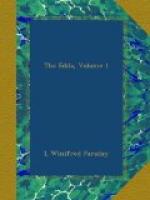Frigg, Odin’s wife and the chief Goddess, daughter of Earth, is not very distinctly characterised, and is often confused with Freyja. Gefion should be the sea-goddess, since that seems to be the meaning of her name, but her functions are apparently usurped by the Wane Njoerd; according to Snorri, she is the patron of those who die unwedded.
Baldr.—The story of Baldr is the most debated point in the Edda. The chief theories advanced are: (1) That it is the oldest part of Norse mythology, and of ritual origin; (2) that Baldr is really a hero transformed into a God; (3) that the legend is a solar myth with or without Christian colouring; (4) that it is entirely borrowed from Mediaeval Greek and Christian sources. This last theory is too ingenious to be credible; and with regard to the third, there is nothing essentially Christian in the chief features of the legend, while the solar idea leaves too much unexplained. The references to the myth in the Elder Edda are:
(1) Vegtamskvida (about 900 A.D.). Odin questions the Sibyl as to the meaning of Baldr’s dreams:
Odin. “For whom are the benches (in hell) strewn with rings, the halls fairly adorned with gold?”
Sibyl. “Here the mead, clear drink, stands brewed for Baldr; the shields are spread. The sons of the Aesir are too merry.”
Odin. “Who will be Baldr’s slayer and rob Odin’s son of life?”
Sibyl. “Hoed bears thither the high branch of fame: he will be Baldr’s slayer and rob Odin’s son of life.”
Odin. “Who will avenge the deed on Hoed and bring Baldr’s slayer to the funeral pyre?”
Sibyl. “Rind bears a son, Vali, in the halls of the west. He shall not wash his hands nor comb his hair till he bears Baldr’s foe to the pyre.”
(2) In Lokasenna Frigg says: “If I had a son like Baldr here in Oegi’s halls, thou shouldst not pass out from the sons of the Aesir, but be slain here in thy anger”; to which Loki replies, “Wilt thou that I speak more ill words, Frigg? I am the cause that thou wilt never more see Baldr ride into the hall.”
(3) In Vafthrudnismal the only reference is Odin’s question, “What said Odin in his son’s ear when he mounted the pyre?”




